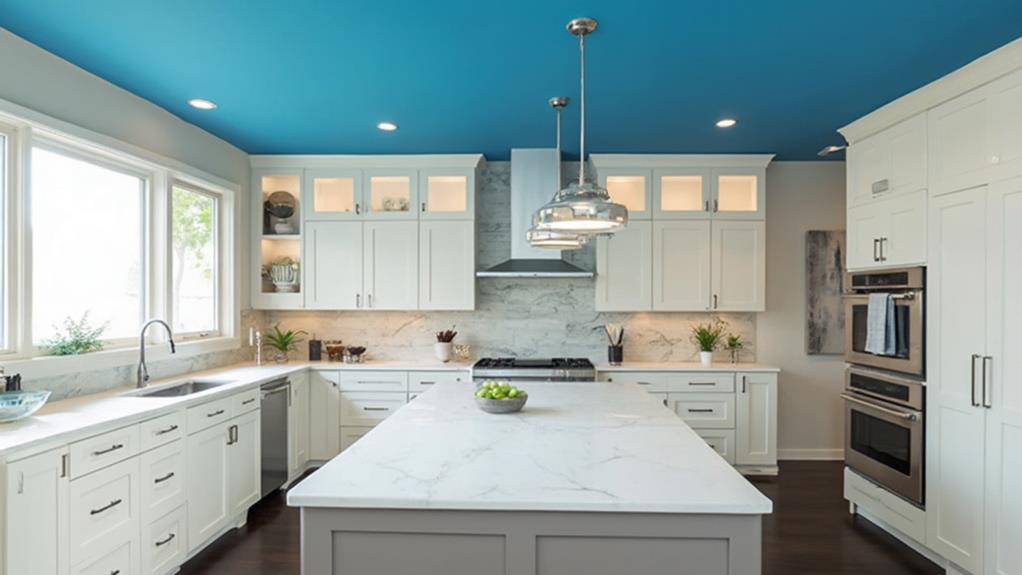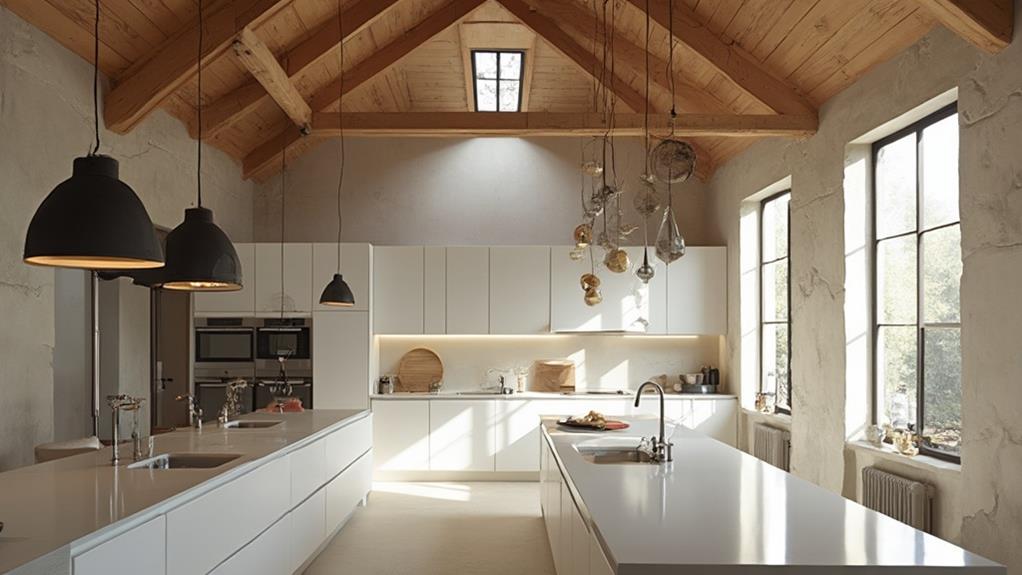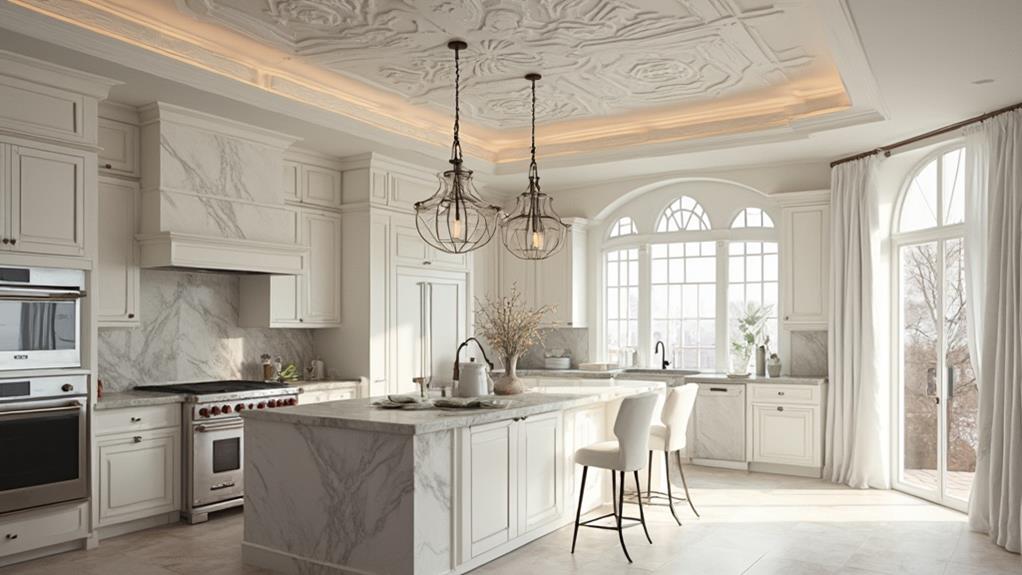Your kitchen's ceiling design profoundly impacts its look and feel. From flat and coffered to vaulted and exposed beam designs, each type creates a unique atmosphere. Lighting integration, color choices, and materials used in construction further enhance the overall ambiance. A well-designed ceiling can make your kitchen appear more spacious, cozy, or dramatic. It can also affect practical aspects like lighting efficiency and noise reduction. Consider your kitchen's size, natural light, and your personal style when choosing a ceiling design. The right choice will transform your kitchen from ordinary to extraordinary. Exploring various options will help you create the perfect culinary space.
Types of Kitchen Ceiling Designs

When it comes to kitchen ceiling designs, you'll find a wide array of options to choose from. The most common type is the flat ceiling, which provides a clean, modern look and maximizes overhead space. If you're after a more traditional feel, consider a coffered ceiling with its grid-like pattern of sunken panels. This design adds depth and architectural interest to your kitchen.
For a touch of elegance, tray ceilings feature a recessed center section that can be painted or adorned with lighting fixtures. Vaulted ceilings, with their sloping sides meeting at a high point, create a sense of spaciousness and grandeur. If you're looking for a rustic charm, exposed beam ceilings showcase wooden structural elements for a warm, inviting atmosphere.
Alternatively, you might opt for a dropped ceiling, which can conceal ductwork and wiring while providing opportunities for creative lighting solutions. For a unique twist, consider a ceiling with decorative tiles or pressed tin panels. These options add texture and visual interest to your kitchen's fifth wall. Each ceiling type offers distinct advantages, so choose one that complements your kitchen's overall style and meets your functional needs.
Lighting and Ceiling Integration
In today's kitchen design, lighting and ceiling integration play a crucial role in creating both functional and aesthetic spaces. When planning your kitchen's ceiling, you'll want to consider how various lighting options can enhance both the look and utility of the room.
Recessed lighting is a popular choice, as it's seamlessly integrated into the ceiling, providing even illumination without cluttering the visual space. You can strategically place these lights to highlight work areas or create ambient lighting throughout the kitchen.
Pendant lights, on the other hand, can serve as striking focal points while providing task lighting over islands or dining areas.
For a modern touch, you might consider LED strip lighting incorporated into tray ceilings or crown molding. This can create a soft, indirect glow that adds depth and dimension to your kitchen. Track lighting offers flexibility, allowing you to adjust and direct light where it's needed most.
When integrating lighting with your ceiling design, consider the color temperature of the bulbs. Warm lights can create a cozy atmosphere, while cooler tones are ideal for task-oriented areas. By carefully planning your lighting and ceiling integration, you'll enhance both the functionality and ambiance of your kitchen.
Color Choices for Kitchen Ceilings

Beyond lighting considerations, the color of your kitchen ceiling can significantly impact the overall look and feel of the space. When choosing a color, consider the size of your kitchen and the amount of natural light it receives.
For smaller kitchens or those with limited natural light, opt for lighter colors like white, cream, or pale yellow to create an illusion of space and brightness. These hues reflect light, making the room feel more open and airy.
If you have a larger kitchen with ample natural light, you can experiment with bolder colors. Deep blues, greens, or even charcoal can add depth and drama to the space. However, ensure these darker shades complement your overall kitchen design and don't overwhelm the room.
For a cohesive look, consider matching your ceiling color to your cabinets or walls. Alternatively, use a contrasting color to create visual interest and define different areas of the kitchen. Don't forget about neutral tones like light gray or beige, which can provide a subtle backdrop for more vibrant elements in your kitchen.
Ultimately, your ceiling color should harmonize with your kitchen's style and enhance its overall ambiance.
Materials for Ceiling Construction
What materials should you consider for your kitchen ceiling? The options are diverse, ranging from traditional to modern choices.
Drywall remains a popular and cost-effective material, offering a smooth finish that's easy to paint or texture. For a more rustic look, wood planks or beadboard can add warmth and character to your kitchen. These materials come in various finishes and can be stained or painted to match your decor.
If you're aiming for a sleek, contemporary feel, consider metal ceiling tiles or panels. They're durable, easy to clean, and can reflect light, making your kitchen appear brighter. Acoustic tiles are another practical option, especially if noise reduction is a priority. They come in various designs and can help absorb sound in busy kitchens.
For a touch of luxury, tin ceilings offer intricate patterns and a vintage appeal. They're available in different finishes, including copper, brass, and chrome. If you want to make a bold statement, consider using glass or acrylic panels. These materials can create a unique, modern look and allow for creative lighting designs. Remember, the material you choose should complement your kitchen's overall style and meet your functional needs.
Ceiling Height Considerations

When it comes to ceiling height in kitchens, you'll need to balance aesthetics with practicality. Standard ceiling heights range from 8 to 9 feet, but you might consider higher ceilings for a more spacious feel. However, be aware that excessively high ceilings can make the space feel cold and impersonal.
For smaller kitchens, a lower ceiling (around 8 feet) can create a cozy atmosphere and improve energy efficiency. In larger kitchens, higher ceilings (9 feet or more) can accommodate taller cabinets and grander light fixtures.
If you're working with an older home, you might encounter lower ceilings; in this case, consider using light colors and reflective surfaces to create the illusion of height.
Remember that ceiling height affects ventilation and lighting. Higher ceilings allow for better air circulation but may require stronger exhaust fans. They also provide more space for natural light, potentially reducing your reliance on artificial lighting. However, you'll need to ensure that task lighting is still effective at counter level.
Consider your kitchen's layout and functionality when deciding on ceiling height. Taller ceilings can accommodate hanging pot racks or pendant lights, but they might make it harder to reach upper cabinets or clean light fixtures.
Conclusion
You've seen how ceiling design can transform your kitchen's ambiance. From various styles to lighting integration, color choices, materials, and height considerations, there's a lot to explore. Did you know that increasing your ceiling height by just one foot can make your kitchen feel up to 50% larger? As you plan your kitchen renovation, don't forget to look up—your ceiling might just be the key to creating the perfect space you've always dreamed of.

